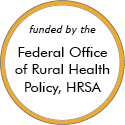Rural Project Examples: Service delivery models
Other Project Examples
HCC of Lafayette County's Heath Information Technology Workgroup

Updated/reviewed December 2023
- Need: To ensure the quality and sustainability of rural West Central Missouri's health services through the use of technology.
- Intervention: The Health Care Coalition of Lafayette County convened a Health Information Technology (HIT) workgroup to establish electronic medical and prescription records, telemedicine capabilities, and training for Lafayette County and surrounding areas.
- Results: The workgroup fully equipped a local emergency department with HIT, launched electronic prescriptions for nearly a dozen Lafayette County providers, and identified acute needs hindering the adoption of electronic health records.
Old Dominion University's Student-Run Mobile Health Clinic

Added November 2023
- Need: To fill gaps in care for rural communities in southeastern Virginia while providing clinical placement opportunities for nursing students.
- Intervention: A free mobile health clinic staffed by Old Dominion University nursing students that visits rural schools and other community centers.
- Results: Hundreds of students have gained hands-on rural experience working in the clinic since its launch.
Project Swaddle
Added August 2023
- Need: To reduce poor maternal and infant health outcomes and improve access to prenatal and postpartum care for at-risk pregnant women and recent mothers in Crawfordsville, Indiana.
- Intervention: A home visitation program that uses community paramedics to deliver wrap-around care to women experiencing high-risk pregnancies and/or social and environmental challenges.
- Results: Since 2018, more than 200 women have been served by the program.
The Minnesota Integrative Behavioral Health Program
Updated/reviewed May 2023
- Need: Out of 79 Critical Access Hospitals (CAHs) surveyed in Minnesota in 2015, behavioral health was the most frequently cited service requested.
- Intervention: In response, Rural Health Innovations launched the Minnesota Integrative Behavioral Health Program. This initiative engaged representatives across all sectors in health integration between hospital, primary care, and community services.
- Results: Strategy sessions resulted in the creation of resource directories to improve care coordination, evaluation measurements to document results, and an overall better understanding of integrative care challenges.
Outer Cape Health Services Community Resource Navigator Program

Updated/reviewed March 2023
- Need: Improving outcomes for Outer and Lower Cape Cod residents in need of social, behavioral health, and substance use disorder services while reducing the burden and costs to town agencies and hospital emergency rooms.
- Intervention: The Community Resource Navigator Program works with local social services, town agencies, faith-based institutions, hospitals, the criminal justice system, and others to identify and connect clients to needed services.
- Results: Clients are gaining access to the care they were once lacking, as measured by improvements in self-sufficiency. The program also helps community partners and stakeholders work together to reduce the impact of risks associated with behavioral health symptoms, substance use disorder, and social determinants of health.
Health-e-Schools

Updated/reviewed October 2022
- Need: Rural school children lack proper healthcare resources within the school setting.
- Intervention: Health-e-Schools provides health services to students via telehealth using video conferencing and special equipment.
- Results: Health-e-Schools increases access to primary healthcare, increases attendance in the classroom, and decreases the amount of time that parents or guardians must take off of work to bring their child to health-related appointments.
Indiana ASPIN Veteran's Services

Updated/reviewed October 2022
- Need: To address the lack of mental healthcare options for rural veterans.
- Intervention: A telebehavioral health hub network was created to connect community mental health centers to the VA Medical Center.
- Results: More than 3,000 telehealth appointments have been made, saving hundreds of veterans time and money.
ASPIN's Certified Recovery Specialist Program


Updated/reviewed September 2022
- Need: Improved approach in addressing the behavioral health and primary care disparities of Indiana's rural counties.
- Intervention: A network was established that trained community health workers (CHWs) to be certified health insurance enrollment navigators and provide mental health services.
- Results: This year, ASPIN trained 230 CHWs, cross-trained 70 behavioral health case managers as CHWs, and 35 individuals in the Indiana Navigator Pre-certification Education.
Maine Critical Access Integrated Paramedics

Added August 2022
- Need: With the nearest hospital more than an hour away, the local community health center in rural Jackman, Maine struggled to maintain its ability to offer 24/7 care to due to staffing and budgetary challenges.
- Intervention: Critical Access Integrated Paramedics provide urgent care to patients after hours and on weekends.
- Results: The Jackman Community Health Center has been able to offer round-the-clock care to clinic patients, while also increasing the level of EMS service available to the community.
Boone County Health Center Pulmonary Rehabilitation Program
Updated/reviewed June 2022
- Need: Evidenced-based intervention to improve function and quality of life for patients with chronic obstructive pulmonary disease and other chronic lower respiratory conditions.
- Intervention: Pulmonary rehabilitation program implementation in 1989.
- Results: Compared to a national average of only about 3% of referred Medicare beneficiaries actually enrolling in pulmonary rehabilitation, 60% of the program's referred patients enroll. Averaging around 15 patients/year completing the program, a large combined cardiac and pulmonary rehabilitation maintenance population averages 8,000 visits/year.
For examples from other sources, see:
